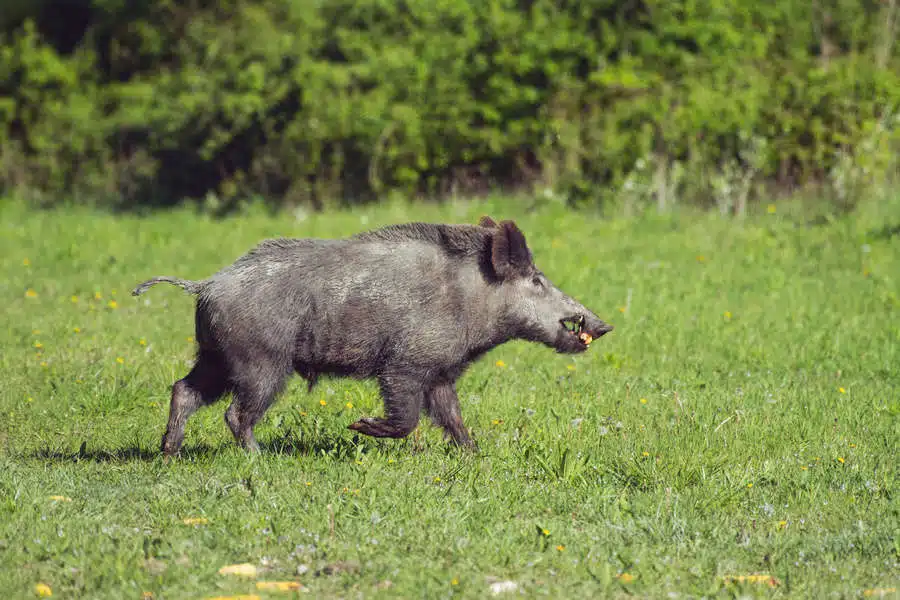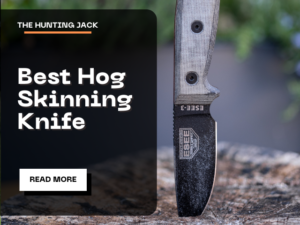Hog hunting has been gaining popularity across the USA for decades now and it is currently in its peak. That is thanks to the alarmingly high rates with which hog populations increase, especially in states like Texas. That is why the government is becoming more and more loose with its laws about hunting wild boars. If you want to get into this, then this small guide will prepare you with some of the best hog hunting tips for beginners I know.
Jack’s Summary:
Hog’s populations are on the rise in our country and hunting them is becoming increasingly popular. Private landowners rely on hog hunters to save their land from the ongoing invasion. This is why many people turn to hog hunting as it is very engaging and often challenging. Knowing how to identify fresh hog tracks, when to hunt them, where to shoot them and what type of gear you need are all essential things you need to be aware of. Lastly, you need to familiarize yourself with the hog hunting legislation surrounding the state in which you will be hunting. Laws are generally loose but there still are restrictions in some states, so keep that in mind.
If you’re looking for a good 308 scope for big-game hunting, head over to my buyer’s guide on the topic!
A deep dive into hogs
Before I go further into any tips or details about hog hunting itself, we have to familiarize ourselves with a few things first. Those are the topics of:
- What is a hog?
- Where does the hog live?
- What are the hog’s sleeping and eating habits?
- Where to hunt hogs?
- Mating habits
Let’s start with the most important question now.
What is a Hog?
Hogs belong to the same family as domestic pigs, wild boars, warthogs, and others. Officially, “boar” is the term used for uncastrated domestic pigs but in reality, people use that term to describe male and female wild pigs. Historically speaking, boars are the ancestors of modern-day domesticated pigs.
“Hogs”, on the other hand, is officially used for pig, swine or a boar over 120 pounds but hunters use that term to describe a pig in the wild, just as it is the case with “boars”. I will refer to the wild pigs as boars or hogs across my article but remember that the main difference is often the size. Most hunters call “boars” the smaller specimen and “hogs” the larger ones.
Sizes
Males across the States usually average around 170-210 pounds and around 30 inches in shoulder height. Females are slightly smaller at 120-170 pounds and 28 inches of height.
The size primarily depends on the number of food boars have and their age. If there is a lot of food in a region and not a lot of hunting happening, the chances are good that you will find hogs at over 200 pounds. Areas that are known for hog hunting generally have smaller specimen due to overhunting preventing them to reach their full growth.
In some parts of Europe, there can be males reaching up to 450 pounds and in some Asian regions, there are 600-pound males. These hogs are basically immune to predators but are also quite rare. There are also cases of huge hogs in the USA.
Where does it live?
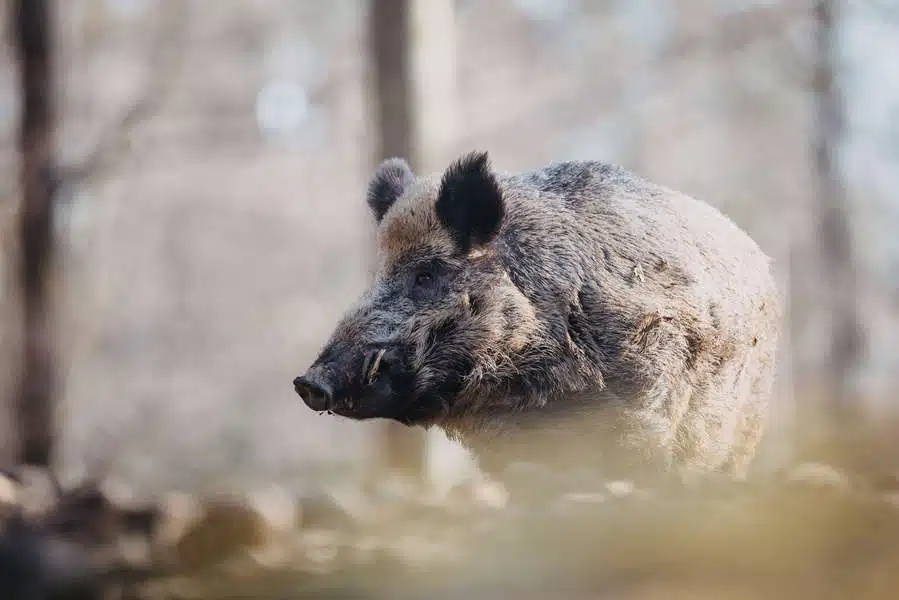
The wild boar inhabits a really large variety of areas including mountain regions, grass fields, woodlands, and even alpine zones above 3000 ft.
The ideal habitat for a boar consists of three major aspects:
- It needs to provide enough shelter from predators (including hunters)
- A reliable water source
- The absence of snowfall for the majority of the year
If an area meets all those requirements, then you have a high chance of finding hogs in it. Still, slight diversions have been noticed across the world. In the US, boards generally prefer mixed forests. They favor forests consisting of primarily beech and oak but other deciduous types of woodlands are also a good option for them. Mix in a few meadows or marshes across those types of woods and you got yourself a perfect wild boar habitat.
Further down, I will list some of the best states in the country that are booming in boar populations currently and you will see that these animals often stray from their ideal environment and adapt to newer ones quite well.
What are the hog’s sleeping and eating habits?
Boars rest and sleep in places called “shelters”. Those shelters are often lined with branches and hay. Wild pigs live in families and they all sleep together at one place, although the male ones sleep slightly separated from the main group.
If you look for a boar shelter, there is a good chance for you to find one near forest streams, swamps or in tall grass or shrub.
Boars sleep during the day, roughly for around 12 hours and are nocturnal animals, meaning they will scout for food during that period. Even though they can become quite large, they have a lot of natural predators. Wolfs are their biggest predator and it is thought that a single wolf can kill up to 80 boars a year.
For that very reason, the wolf’s successor – the dog is really good at finding hogs. Experienced hunters often look for some of the best dog breeds for hunting wild boar or other animals.
In terms of eating, the wild boar is an omnivore, meaning they have a mixed diet of plants and meat depending on the circumstances. There are four types of food they look for:
- Roots which are a good source of energy all year round
- Berries, seeds, and berries which can also be found through various times of the year
- Leaves and bark, even garbage when necessary
- Insects, fish, rodents, bird eggs, snakes, frogs, earthworms, and mollusks
Boards above 100 pounds usually need more than 4000 calories a day and they mostly supply them from food that is in the ground – roots, burrowed animals, etc. Acorns are one of the favorite snacks, though, and that is why hunters often use it in the feeders.
Mating Habits
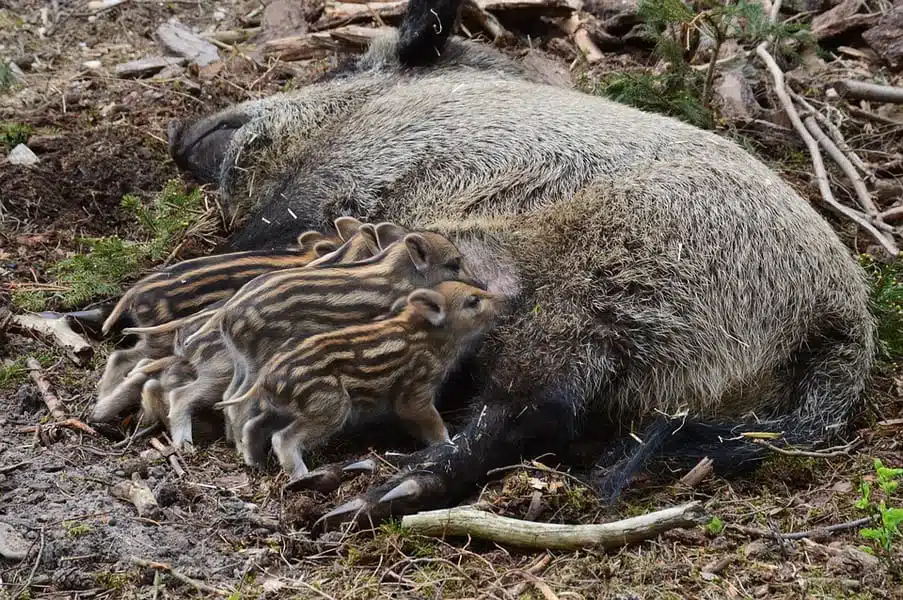
Mating usually occurs from November to January. It is also called the “rut” and is the period in which boars are the most active, especially males. These male boars develop a subcutaneous protective layer and spend all of their time in the search for a sounder of sows (a gathering of female boars). Once they find a female, they fight off any potential competition or other small animals around her. At the end of the rut, males are often badly wounded and have a significant portion of their body mass.
The gestation of the female hog (sow) lasts roughly around 110 days which tells you that early spring is full of piglets. A single sow can give birth from 1 to 11 piglets and can do so twice a year. All that should explain why their population is growing by such uncontrollable numbers each year.
Now, let’s take a look at which are the best places in the US for hog hunters.
The best states for hunting wild hogs
States’ laws vary a lot but in general hog hunting is allowed all year round with a hunting license on private land in most states. In the last two decades, hog hunting has become very popular mainly due to the fact that these animals are booming all across the United States. Some state populations are conservatively estimated at more than a million.
Here are some of the states that I think are the current best places to go hog hunting:
- Louisiana
- Florida
- Texas
There are other ones like California, Arkansas, Alabama and others that are equally good locations for hog hunting. Still, purely metrics wise, these three listed states are the biggest in wild boar populations and are the go-to places for hog hunters.
Texas
Texas is by far the best place to hunt wild boars today. It has a population of more than 1.5 million boars and is currently losing the war against these animals. There is a reported 15-20% increase in their population each year which is quite troubling since hogs can be quite destructive.
The state of Texas allows hog hunting all year round and there are no bag limits. The limitations aren’t many as well. Unlike most other states, here you can:
- Hunt from a helicopter
- Hunt with a suppressor
- Hunt during the night
- Bait the hogs
Private land hunting isn’t great over there, though, but guided hog hunts are on the rise and are a decent enough alternative.
Louisiana
Louisiana is yet another state where the wild boar population is nearing one million. Thanks to that, the local government has reduced the limitations hog hunters have. Just like with Texas, there is no hunting season and no bag limit. One slight disadvantage is that if you want to hunt at night it must be done on private property.
Florida
Florida is thought to be the first state in which hogs were released by Spanish explorers during the 15th century. This combined with the suitable habitat there is one of the
reasons why Florida is home to one of the largest wild boar populations in the USA.
The main thing here is that you don’t even need a hunting license to kill hogs on private land in Florida. You will need that only if you hunt on public lands. Florida has a lot of rains and usually, that restricts the ground area which hogs can cover. If you have an expert guide you can find those restricted ground patches in which you will definitely find a large number of hogs.
If you want to read on more in-depth information about each of the 50 states, head over to my article on state-by-state hog hunting regulations.
Now that we’ve gone through the places and states you can hunt hogs into, let’s check out some of the best times of the year and the day that you can do that…
Hog Hunting Equipment
If you are going to hunt on a private ranch, they will most likely have the list of items you need to bring along so I am not going to go too deep into that. Just remember to bring your night vision gear (and extra batteries!) if you are going on a night hunt, and always have the appropriate clothing for the weather. A pair of binoculars or a spotting scope won’t hurt as well, although it will add weight to your gear.
Apart from that, I wanted to focus on the rifle and the ammo as those are the two most vital components. These are also the items that beginners usually struggle with.
Best rifles for hog hunting
Basically any rifle that is good for shooting down a coyote or a deer will be good for a hog. Still, I have prepared a few rifles which are famous and good enough for the job:
- Browning BAR ShorTrac Hog Stalker

This rifle has served the American military for more than a century now and its hog hunting modifications are what make it the (almost) perfect rifle for hog hunting. It is one of the most famous 10-mag .308 semi-auto rifles out there and it really feels like a deer hunting rifle. Apart from the pistol hold, everything about this rifle is great. It sports one of the best camo patterns out there and has a ton of good features such as the full-length stock and the lengthy Picatinny rail. Add the famous BAR accuracy to all that and you got yourself the ultimate hog hunting rifle.
- Remington AR-25

If you want a rifle that is capable of shooting multiple pigs at the same time, then this is the way to go. Usually, a .223 Remington chambered rifle will do the job, but the Remington R-25 in .308 Winchester is a force to be reckoned with. The rifle is accurate enough, very reliable and is compatible with a bunch of optics and accessories needed for your hunt. For hog-control, this should definitely be on your list.
- Ruger American Rifle

For people that are looking for a bolt-action rifle, I recommend the Ruger American. It is very accurate, decently priced and superb on long-distance shots from a static position. If you are hunting over a hog bait site, you should consider this rifle. It isn’t a hog-control rifle but it should do the job if you just hunt occasionally or want to put some pork on the dinner table.
Best Caliber For Hog Hunting
I want to go through some of the most commonly used cartridges and showcase their pros and cons to you now. Let’s start with the best one…
- .308 Winchester – The .308 Winchester gets the job done – simple as that. It is powerful enough to inflict a kill shot in any of the vital spots of the pig, unlike some smaller caliber rounds. Just take a look at what happens when the .308 finds its target (around the 2-minute mark):
- .30-06 Springfield – This round is quite similar to the .308. It is very accurate, deadly, and powerful even in the hands of a novice hog hunter!
- .270 Winchester – A bolt-action .270 will pack enough punch to put a little piglet down as well as a huge hog if its in the right hands.
What is the best time to hunt wild hogs?
As I mentioned earlier, hog hunting is often done at night, even though some states allow day-time hunting only. Still, a workaround is to hunt on private land during the night as that is mostly permitted across the country. Still, I will try to cover all aspects when it comes to the time of the day and time of the year in which you can hunt hogs. Let’s start with the most important one:
Hog hunting at night
Hunting during the night is challenging due to the nature of the hunt itself. You don’t have a clear view out in the fields or forests unless you have geared up properly. You will also have to do a lot of tracking and chasing, so physical endurance has to be spot on.
Apart from overhead night vision gear, the second best alternative (which is also a notch cheaper) are night vision spotting scopes or regular night vision scopes. One particular model that I really enjoy is the ATN X-Sight Day & Night Scope which can easily pick up targets at around 150 yards (up to 300 yards with an upgraded IR illuminator) and is an overall great bang for the buck. For further ranges, I would suggest a good thermal scope.
Hogs are most active during the night, meaning they will be looking for all sorts of food to supplement themselves for the next 24 hours. On private lands, those are most often agricultural lands. Landowners often invite people to hunt in their property (which in some states doesn’t even require a permit) just because those boars are capable of inflicting great amounts of damage to crops.
Jack’s Tip: If you are sure of the terrain you want to hunt on during the night, make sure you scout it out and familiarize yourself with it during the day. That way, it will be much easier to navigate through the dark night. Having a spotter with you or a group of fellow hunters is always better, especially if you are used to hunt together.
“Bait and Wait”
Every hunter has heard that phrase and there is a good reason for that. Most night hunters rely on that tactic to hunt hogs, as they scout for food and a strategically placed feeder can be their doom. Still, try not waiting too close to the bait and think of investing in a scent killer that won’t give away your position.
Attaching a red light around or beneath the feeder is a good way to keep your targets illuminated when you take the shot. If you are hunting on a moonlit night, you can even go by with a regular riflescope with only an illuminated reticle. Remember that white or bright lights will scare the hogs away. Some of the baits that boars like the most are:
- Shelled corn
- Acorns
- Overripe fruits
- Nuts
- Sweet potatoes
Jack’s Tip: Soak your bait in beer and watch the magic happen!
One final thing I want to say is to always check with your state’s requirements about hog hunting at night. It is mostly permitted on private lands but there are a few exceptions.
Hog day hunting
Hog hunting during the day is a little tricky. Most hogs will take the day off and rest to gather energy for the upcoming night. Still, it is perfectly acceptable to hunt hogs while the sun is still up (well… almost). The thing is that you can use the first few hours of the day as well as the last few ones. Early in the morning and late in the evening are the hours when hogs are the most active. Still, during the winter months boars as just as active in the middle of the day as they are at night since they are constantly looking for food. Click here if you want to learn some of my best tips on hunting in the snow.
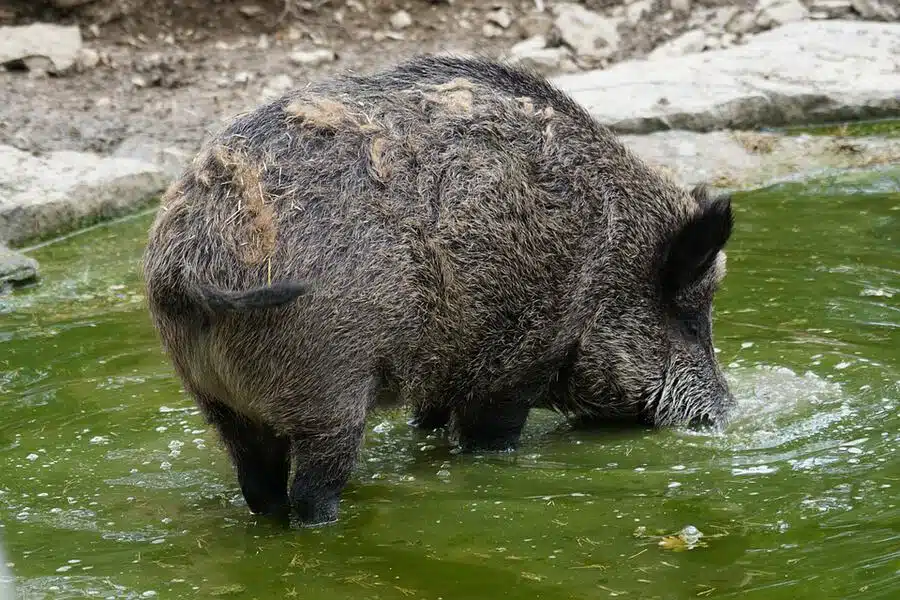
During noon hogs will be at their shelters and confronting them there isn’t a very bright idea, at least not if you value your health. Still, tracking down male hogs is far easier during the day. That way you can scout for a bigger hog and see what its habits are (if the soil is generous enough to provide you with good trails). During the rut males don’t spend too much time sleeping and would rather spend their time looking for sows. That is exactly when you can track and shoot one. Other than that, your chances of finding hogs at night are way higher but that usually requires more planning, preparation, and more expensive gear.
Now that I’ve been through the parts of the day, let’s check out the best parts of the year that you can go out and enjoy some hog hunting.
Seasonal Hunting
Many hunters unanimously agree that the best period of the year to hunt hogs is along with deer season (late fall and winter). This is because hogs will be more active then due to the rut being in its peak and they will also be hungrier (especially in January and February). Those are the months where feeders also work like a charm.
Early spring is also a good time for night hunting as there is a sudden abundance of food and boars are out feasting. Still, watch out for angry sow mamas as there is nothing that can get in their way when it comes to their piglets.
Apart from the time of the day and year, there are several other environmental factors that can affect the way hogs behave and how they react to their surroundings. Let’s dive into that now.
Weather Conditions
There are some things that play a major part in a hog’s decision to go out or stay hidden. Here are a few of them:
- Air pressure – low atmospheric pressure will keep scents relatively low on the ground and will affect how your scent sticks around. On those days you might want to consider hunting from a stand. High atmospheric air pressure will result in your scent going higher which is good for you and bad for the hog. It is important to understand that hogs have one of the most acute senses of smell in the animal kingdom and all these factors are listed here for a reason. If you really want to stay hidden, it might be also a good idea to consider getting a good ghillie suit.
- Wind – The most important thing you need to remember for hog hunting is to always hunt downwind from the place where you think the hogs are. If you are hunting upwind you will 100% get spotted or at least give away your position if you aren’t properly concealed scent-wise.
- Temperature – The colder it is, the more likely is for the hog to travel further in search of food since it will need more food to keep itself warm. Subzero morning and evening temperatures make for prime hog hunting conditions.
- General conditions – Hogs go on the move during a cold or rainy front. Those are the times when you have high chances of finding one. Still, beware of the wind conditions.
Another thing that is widely disregarded but important nonetheless is the moon phase.
How to track hogs
There are two major ways to hunt wild hogs:
- Wait for them at a strategically picked spot
- Track them on foot
Waiting isn’t everybody’s game and it definitely requires more patience than being engaged in a tracking process.
The best strategy for people who want to wait it out is to find a good water source and pick a good position from which they have a clear view out to all of the water shores. Usually, hogs like to drink water just after sunrise so that they can bed comfortably for the rest of the day.
Another way to wait for them is to set up feeders and do a little baiting but more on that later.
For now, we will go through the tracking process. The most important thing you need to remember is this – hogs love water. I always start my tracking from a good water source and look for:
- Fresh excrements
- Muddied up holes
- Tracks in the wet soil
If the day/week has been very dry then you will have to rely on excrements and feeding patterns only. If it has been raining and the ground is muddy then tracks are your main source of information. Here is a picture of how a hog track looks like. It is similar to the deer ones (two-toed) but is more rounded.
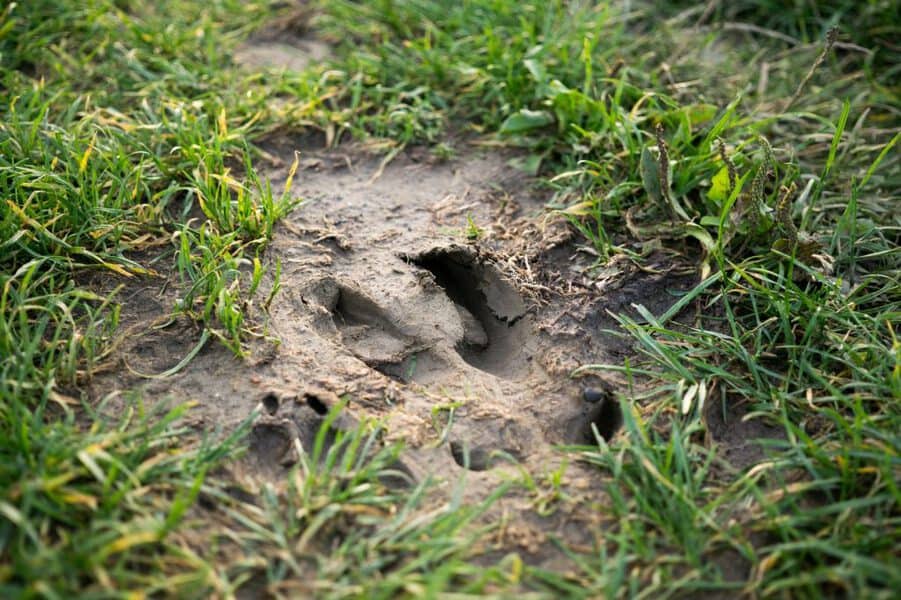
If the poop has the consistency of oatmeal, that is a fresh sign and you are close behind. When you get closer start using your nose and ears. You can usually hear them moving through the brush (although they can sometimes pass 20 yards from you and you wouldn’t hear a thing). One thing that will never let you down, though, is your nose.
Hogs smell like cattle and that easily gives them away when they are close by.
Tracking is ideally done during the early hours of the day as well as the very late ones. Still, I prefer morning hunts as they can extend longer if you are on the right track and you have plenty of daylight to play with once you get on a track. If you are hunting on private land you will be able to learn their eating, drinking, and bedding habits after they have gone silent for the day.
A good scouting of the private land can also pinpoint spots in which you can later on set up traps or baits and have a little night hunting session. Let’s get into baiting now.
Baiting
The subject of baiting is really important and it has become the core of modern-day hog hunting. It still requires you to know a few things and have a good idea of how to properly set up your bait and what to expect from it.
Baiting is in the center of the tree and ground stand hunting tactics but it is used predominantly for deer hunting while hunters here just set up a comfortable position without any stands or blinds and bait the hogs out in the open about 100 yards from them. All you will need is your rifle, a tripod, and some night-vision equipment if you are going to do it during the night.
The best way to bait boars is through feeders. Those can be manual (gravitational) or electric ones which can be controlled via signal. That way you can serve dinner exactly when you have taken your position. Late autumn and winter are two especially successful seasons for this type of hunting since hogs don’t have too many food supplies during that part of the year.
Jack’s Tip: Make sure you are downwind from the place in which you set up the feeder, otherwise it will all be in vain. Remember that an older experienced hog will know about your presence way before you know about it. After that happens, it is a game of cat and mouse or “who is more hungry than the other”.
You can even use certain scents or calls but those have limited success and aren’t part of the usual arsenal of hog hunters.
Other Ways To Find Hogs
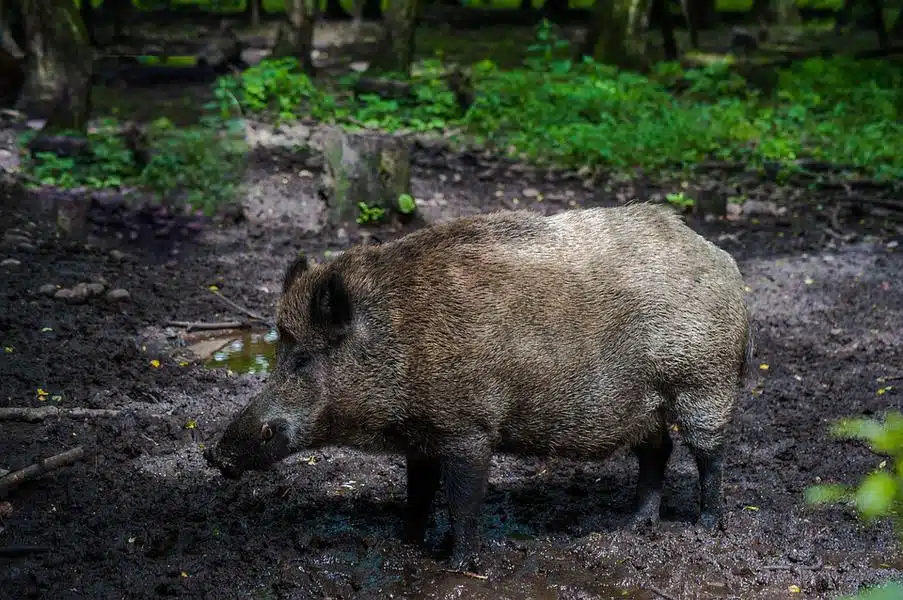
Hogs are creatures of habits and they almost never change them. That refers to their eating, bedding, and moving habits which can only be changed by fluctuations in food sources or the climate. In all other cases, their bedding, routes, and water sources stay the same. Identify where those are, and you will vastly increase your chances of intercepting them in their active hours. Let’s take a look at some of those habits now…
- Travel Lanes – Wild boars usually use the same routes on their way to food and water sources from their bedding area. They often navigate through the thick woody bush where the ground is clear and there isn’t a lot of tall grass. You can scout where several of those passages converge and create a good downwind spot for ambushing them.
- Crossings – When hunting on private land there must be a gap in the fence somewhere where pigs cross. That is the place that you should scout for and ambush them on their way through. These crossings are also a good point to start your look for bedding areas and feeding grounds.
- Wallows – Wallows are places created by wild animals and are usually ditches that have some water in them which is a good place for a mud bath. Hogs go to wallows to cool themselves down and get relief from all those biting bugs. Hunting wallows is usually the best idea on hot days/nights and isn’t such a bright idea on chilly or cold days.
- Food sources – Hogs constantly change their eating habits from meadows and lush fields in the Spring to places with ripe fruits in the early Autumn. If there are crops nearby that is also a sure place to find hogs, as they love crops like grains or melons. Look for evidence of rooting activity (small holes in the ground dug up by the hogs in look for roots).
You can combine all these methods in your scouting and tracking or just pick one on which you will emphasize and stick to it. Most people prefer waiting at the water source in the early hours of the day as this is the one sure thing hogs will do before bedding – drink water. Still, if you want to move around and enjoy nature a little further, tracking down their routes and crossings will be rewarding, trust me.
Once you find your hog, there is one last thing you need to focus on…
Where to shoot the hog?
Most hog hunters are usually deer hunters looking for a game to hunt in the off-season. This is good but it opens the door for a few potential mistakes.
The hog’s anatomy is slightly different than the one of the deer mainly due to the fact that the lungs and heart are located above the shoulder. An experienced deer hunter might go for the vital organs and end up with a gutshot boar, which isn’t an ideal scenario because you will have to go trailing after your shot.
Your kill shot must be quick and clean which results in an ethical, safe for you, and efficient hunting experience.
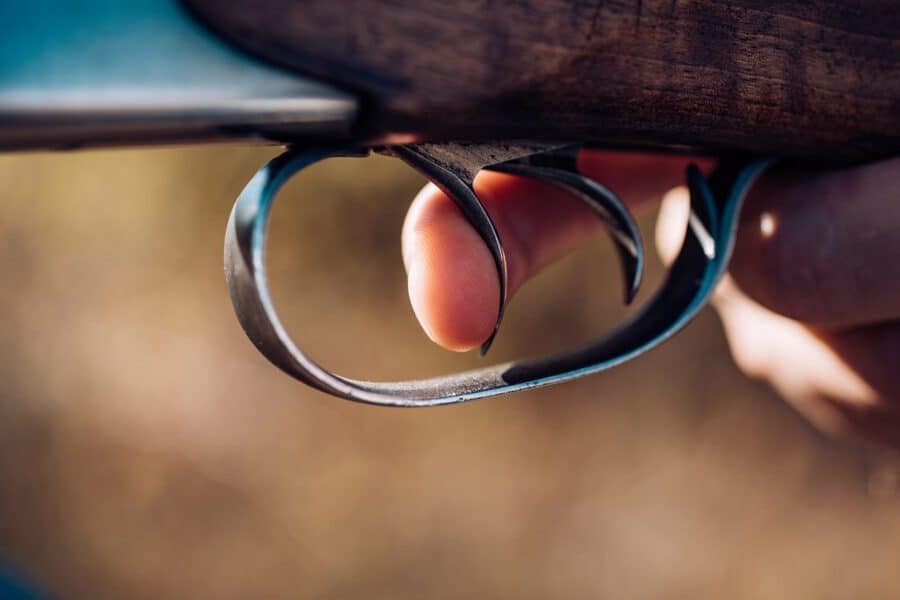
Of course, neck shots and headshots are quite deadly just like a shot to the heart but are also harder targets to hit than the chest of the hog. The head is covered in thick hide and the skull is quite strong as well. For being on the smarter spectrum, hogs don’t really have that big of a brain, making it an even harder target. Often we hear the stories about hunters that are absolutely sure they hit a headshot only to get close and have the hog charge at them.
In case you are aiming for the head, make sure you choose the right ammo which will be heavy enough to penetrate the hide and the skull. Usually, a .308 will do the job, although many hunters hunt with a .223 caliber.
Now, let’s summarize all that we just learned into a list of the most essential tips you should always have in mind while going out hog hunting…
My top 10 tips for a beginner hog hunter
There is a lot of information to absorb and process here but at the end of the day, hunting hogs can be boiled down to these 10 crucial tips. Learn them well and you will be one step closer to becoming a successful hog hunter. So, let’s check them out:
- Hogs live in deciduous and mixed forests that don’t get too much snowfall, have good food and water supply and are covered with thick brush. If you hunt in an area that checks all the boxes you are already in the hog’s home.
- Hogs sleep during the day and are most active throughout the night. If you want to hunt during the bright hours, your best chance of spotting a hog is in the early morning and late evening. Other than that, you will have to resort to night hunting.
- Each state has its own hog hunting laws, although they are mostly quite loose, especially since hog populations are increasing rapidly across the country.
- Seek out private landowners that are looking for people to hunt the hogs that are ruining their land. Some states don’t even require a private land hog hunting permit so you will have a full pass on the hunt and the owner’s gratitude after you take out a few hogs.
- Hogs love drinking water before they go to their bedding. In the early hours of the morning, hogs will go to their water source. Wait for them there.
- Hogs are creatures of habit and often follow the same trails. Find those trails and crossings and see where they merge. Ambush them by positioning yourself downwind.
- If you want to bait hogs using a feeder, make sure you use some of their favorite foods – nuts, ripe fruits, acorns. Soak them in beer for better results. Place the feeder in a wide-open area to which you have a clear view.
- Wild boars have an incredible sense of scent. If you are upwind from them, they will know about your presence before you even see them.
- Having a good rifle with the right cartridge is important, especially if you are going for a headshot. Their brains are relatively small and the thick hide and skull make headshots tricky unless your weapon packs some firepower.
- Their lungs and heart are located right above their front shoulder. In deer, they are lower and hunters who transition from deer to hogs often shoot the hog in the gut and leave empty-handed or have to track the shot hog.
- Always be ethical about your hunting. If your initial shot doesn’t kill the animal on the spot, quickly but safely approach it and end its suffering.
Frequently Asked Questions
What is the ideal cartridge for hog hunting?
I will always say the .308 Winchester as it is the one I use both for hog and deer hunting but there are a lot of other hunters that use smaller calibers and are doing just fine.
Is wild boar meat good to eat?
If the boar you’ve killed is over 140-160 pounds it will make for some epic pork chops. The rest of the meat can be used for sausages. The best meat comes from the younger hogs and it all depends on how you butcher and cook the boar.
Will a 223 kill a wild hog?
The .233 (5.56) isn’t the most ideal cartridge out there for hog hunting. It will kill a small boar but will struggle with a large hog.
Final Words
I hope that I have been helpful with your new endeavor into the world of hog hunting and that some of my hog hunting tips for beginners will be put into good use. As with hunting any other animal type, there are things here that you can only learn through experience and the more you hunt the better your hunting instincts will get, which will ultimately make you more relaxed and confident when you are out there tracking hogs.
